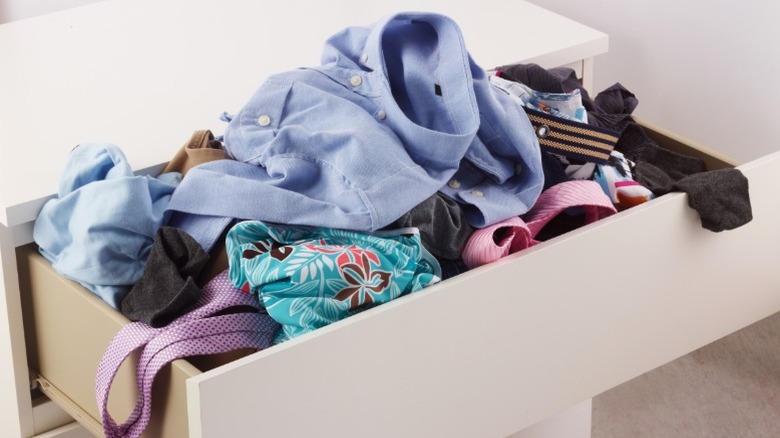The Unexpected Way You Could Be Ruining Your Dresser
If you are scrambling for a little bit of extra storage space, it's easy for your dresser to become a catch-all for anything without a designated home. Whether we're managing an overflow of shirts and pants, spare linens, or a haphazard collection of seasonal items, we often treat our dresser drawers like bottomless pits, especially if we can't fit a more creative storage solution for a room without a closet. We think that if we're able to cram in that one last sweater and force the drawer shut, we've conquered clutter for another day. However, what feels like a victory over clutter can actually be a slow, silent killer for your beloved furniture piece.
This tendency to overstuff drawers is an unexpected issue homeowners often overlook. Many people only care about how it looks externally and not about its internal and structural integrity. But no matter how sturdy the furniture appears from the outside, these pieces will eventually fail unless you employ some organization tricks to keep your dresser drawers clutter-free. Drawers run on slides, and drawer boxes are commonly held together by joints. When you consistently pack these compartments to the brim (or even past it), you introduce chronic stress to these connections, likely pushing the weight beyond manufacturer's recommendation. Constructions vary, meaning some dresser drawers are stronger than others. If yours have steel ball-bearing glides, for instance, the drawers will typically bear more weight than those with center-mount or plastic roller glides. Still, every build will have its breaking point. While stuffing your drawers seems innocent, the extra force and pressure can lead to premature wear and tear.
Sagging, warping, and other damage from overloaded drawers
Chronically overstuffing drawers eventually takes a big toll on your dresser's structure. The most immediate and visible sign of this strain is sagging. The drawer bottom (often made of a thinner wood or composite board), was not built to support an excessive, unbalanced load. Over time, gravity pulls on heavy contents, causing the base to bow in the center. It's this sagging that compromises the drawer box's rigidity and can eventually lead to breaks or parts becoming loose. Simultaneously, the strain affects those slides or runners, the parts that let the drawer move smoothly. If a drawer is continuously overloaded, it could cause the runners to bend or even detach from the dresser frame.
Overloading also leads to long-term damage like warping and misaligning. The non-stop uneven pressure can make the whole wooden structure of the drawer frame to twist or warp slightly over time, especially in dressers made of engineered wood or any natural wood susceptible to humidity changes. And it's that warping that leads to problems like drawers not closing smoothly, sitting unevenly, being hard to close, or rubbing against the frame. So, to lessen this damage and give your dresser a fighting chance, try to place excess items elsewhere, like in these storage solutions from IKEA for under $50. For items you end up storing in your dresser drawer, aim for even weight distribution. Instead of cramming all your jeans into one drawer or making it heavy on one side, spread the load equally across all drawers. By being mindful of weight, you're using your furniture as it was designed and helping to maximize its lifespan.

